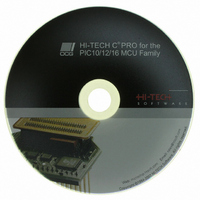SW500010 Microchip Technology, SW500010 Datasheet - Page 95

SW500010
Manufacturer Part Number
SW500010
Description
HI-TECH C PRO FOR PIC10/12/16
Manufacturer
Microchip Technology
Type
Compilerr
Series
PIC10/12/16r
Specifications of SW500010
Supported Families
PIC10, PIC12, PIC16
Core Architecture
PIC
Software Edition
Professional
Kit Contents
Software And Docs
Mcu Supported Families
PIC10/12/16
Tool Type
Compiler
Lead Free Status / RoHS Status
Not applicable / Not applicable
For Use With/related Products
PIC10, PIC12, PIC14, PIC16, PIC16E
Lead Free Status / Rohs Status
Lead free / RoHS Compliant
Other names
019P
778-1006
778-1006
778-1006
778-1006
- Current page: 95 of 502
- Download datasheet (3Mb)
C Language Features
result.
3.7.3 Division and modulus with integral types
The sign of the result of division with integers when either operand is negative is implementation
specific. Table
when compiled with HI-TECH C.
3.8 Psects
The compiler splits code and data objects into a number of standard program sections referred to
as psects. The HI-TECH assembler allows an arbitrary number of named psects to be included in
assembler code. The linker will group all data for a particular psect into a single segment.
documented here, except as background knowledge. If you want to run the linker manually (this is
not recommended), or write your own assembly language subroutines, you should read this section
carefully.
4.3.8.3). In C, user-defined psects can be created by using the #pragma psect preprocessor
directive.
3.8.1 Compiler-generated Psects
The code generator places code and data into psects with standard names which are subsequent
positioned by the default linker options. These psects are described below.
checksum If a checksum has been requested, the result will be stored in this psect.
Left shifts (< < operator), signed or unsigned, always clear the least significant bit of the
In the case where the second operand is zero (division by zero), the result will always be zero.
If you are using PICC to invoke the linker, you don’t need to worry about the information
A psect can be created in assembler code by using the PSECT assembler directive (see Section
The compiler-generated psects which are placed in the program space are:
3.5
shows the expected sign of the result of the division of operand 1 with operand 2
Operand 1
+
+
-
-
Table 3.5: Integral division
Operand 2
+
+
-
-
Quotient
+
+
-
-
Remainder
+
+
-
-
Psects
95
Related parts for SW500010
Image
Part Number
Description
Manufacturer
Datasheet
Request
R

Part Number:
Description:
Manufacturer:
Microchip Technology Inc.
Datasheet:

Part Number:
Description:
Manufacturer:
Microchip Technology Inc.
Datasheet:

Part Number:
Description:
Manufacturer:
Microchip Technology Inc.
Datasheet:

Part Number:
Description:
Manufacturer:
Microchip Technology Inc.
Datasheet:

Part Number:
Description:
Manufacturer:
Microchip Technology Inc.
Datasheet:

Part Number:
Description:
Manufacturer:
Microchip Technology Inc.
Datasheet:

Part Number:
Description:
Manufacturer:
Microchip Technology Inc.
Datasheet:

Part Number:
Description:
Manufacturer:
Microchip Technology Inc.
Datasheet:










